Uncover the secrets of the human immune system with our comprehensive notes, featuring detailed explanations, diagrams, and insights into immunity, lymphocytes, and antibodies.
The immune system acts as our body’s strong defense mechanism. It works against invading microorganisms to maintain our health. Immunology, a branch of biology, explores the intricate functions of the immune system. The capability to combat antigens or pathogens and stay healthy is known as immunity. Comprising cells, tissues, and organs, the immune system collaborates to shield our bodies. This system safeguards us from harmful invaders through various means.
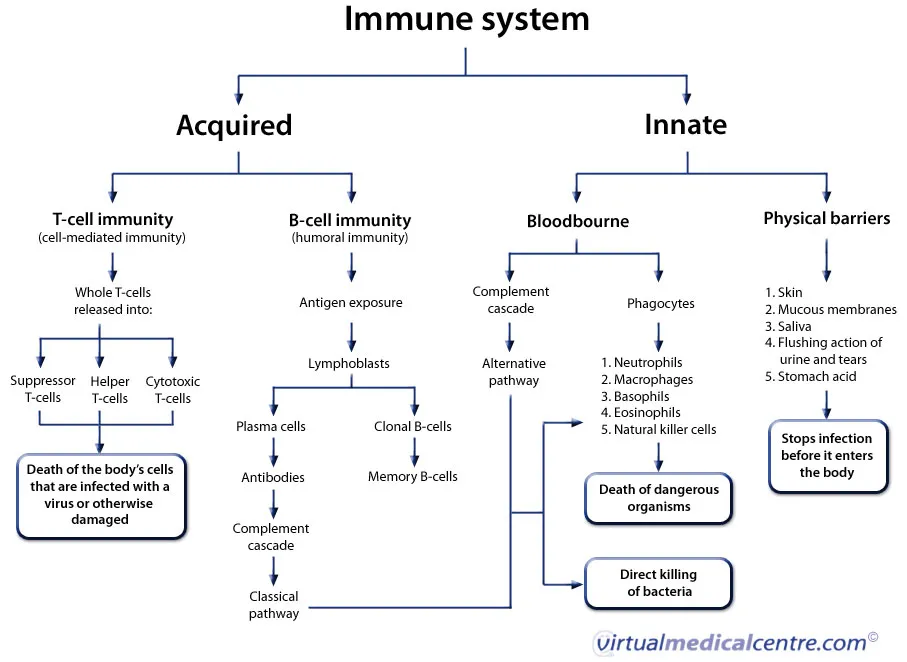
What is Immunity?
Immunity is the remarkable ability of our body to recognize, fight, and remember harmful invaders, keeping us healthy and preventing infections. It’s like a complex defense system with various lines of defense, working together to neutralize threats before they can cause harm.
What is the Immune System?
The immune system is a vast network comprising organs, white blood cells, proteins, and chemicals. These components collaborate to shield you from germs and other intruders. Additionally, your immune system plays a crucial role in aiding your body’s recovery from infections and injuries.
What does the immune system do?
Your immune system has a crucial role in keeping you healthy. It achieves this by:
- Preventing invaders (such as germs) from entering your body.
- Eliminating invaders.
- Controlling the harm invaders can cause if they’re inside your body.
- Repairing damage to your body.
- Adapting to face new challenges and threats.
The invaders your immune system protects you against include:
- Bacteria.
- Viruses.
- Fungi that can cause infections.
- Parasites.
- Cancer cells.
Types of Immunity
Immunity is the capability of host cells to combat disease-causing microorganisms through the immune system. There are two types of immunity.
Innate Immunity
Innate immunity is described as the non-specific defense mechanisms present since birth, offering various barriers against the entry of foreign agents into the body. It includes four types of barriers:
- Physical Barrier: This involves the skin and the mucus coating of the epithelium lining the respiratory, gastrointestinal, and urogenital tracts.
- Physiological Barrier: Acid in the stomach and saliva in the mouth contribute to this type of barrier.
- Cellular Barrier: Leucocytes, neutrophils, and monocytes play a crucial role in this defense mechanism.
- Cytokine Barriers: Virus-infected cells release a protein called interferon, contributing to the immune response.
Acquired Immunity
- Acquired immunity, also known as adaptive immunity, is the defense that our body develops over time. Unlike innate immunity, it is not present from birth.
- The immune system’s capacity to adjust to diseases and produce immunity specific to pathogens is referred to as acquired immunity or adaptive immunity. This type of immunity is gained after birth and is often termed adaptive immunity.
Active Immunity
- Active immunity is characterized by the direct response of the immune system to foreign antigens within the body. In the context of the acquired or adaptive immune system, the body retains a memory of the pathogens it has previously encountered. This memory is a direct outcome of the active immune system.
- Active immunity takes place when we come into contact with the pathogen or its antigen.
- Antigens, short for antibody generators, play a crucial role. It is through the antigens released by the pathogen that our body combats and addresses the threat posed by the pathogen.
Passive Immunity
- Passive immunity occurs when the immune response is initiated by antibodies acquired from an external source. The initial response of the body to a pathogen encountered for the first time is relatively weak, making the first encounter somewhat challenging for the body.
- Passive immunity develops rapidly, allowing our body to launch an immediate attack on the pathogen.
Difference Between Innate Immunity and Acquired Immunity
| Innate Immunity | Acquired Immunity |
|---|---|
| Present since birth | Develops over a lifetime |
| Immunity persists throughout life | Duration can be temporary or lifelong |
| Not necessarily dependent on contact | Requires exposure to a pathogen or its antigen |
| Innate immunity can be inherited | Acquired immunity generally cannot be transmitted to the next generation, except for a short period to neonates |
| Safeguards against diseases from other organisms | Provides protection against pathogens found in other members of the same species |
Lymphocytes
Lymphocytes are a special kind of white blood cell that plays a crucial role in the immune system. They have different jobs that help the body defend itself against harmful intruders. Some lymphocytes act independently, while others collaborate with fellow cells.
There are two main types of lymphocytes:
- B-lymphocytes (B cells)
- T-lymphocytes (T cells)
Difference Between B Cells and T Cells
| Basis for Comparison | B-Lymphocytes | T-Lymphocytes |
|---|---|---|
| Site of Maturation | Originate and mature in the bone marrow | Originate in the bone marrow, mature in the thymus |
| Position | Mature B cells occur mostly outside the lymph node | Mature T cells occur mostly inside the lymph node |
| Distribution | Germinal centers of lymph nodes, spleen, gut, respiratory tract; also subcapsular and medullary cords of lymph nodes | Parafollicular areas of cortex in lymph nodes, periarteriolar in the spleen |
| Type of Immunity | Involved in humoral (antibody-mediated) immunity | Involved in cell-mediated immunity |
| Relationship | B cells are also Antigen Presenting cells, presenting antigens to T-cells | Help activate B cells and aid in antibody production against T-dependent antigens |
| Secretory Product | Antibodies are the chief secretory product of B cells | Cytokines (lymphokines) are the chief secretory product of T cells |
| Receptors | B-cell receptors (BCRs) constitute membrane antibodies known as immunoglobulin surface receptors | Surface receptors are called T-cell receptors (TCRs) and differ from membrane antibodies |
| Life Span | Comparatively shorter life span | Comparatively longer life span |
| Functions | Help eliminate free foreign invaders by enhancing immune responses against them; provide immunity against most foreign antigens and bacteria | Help lyse virus-infected cells and tumor cells; provide immunity against most viruses and intracellular bacterial pathogens; help B cells in antibody production |
Structure of Antibody
- An antibody has a unique structure shaped like the letter “Y,” comprising four building blocks called polypeptide subunits. Within each subunit, there are two similar light chains and heavy chains.
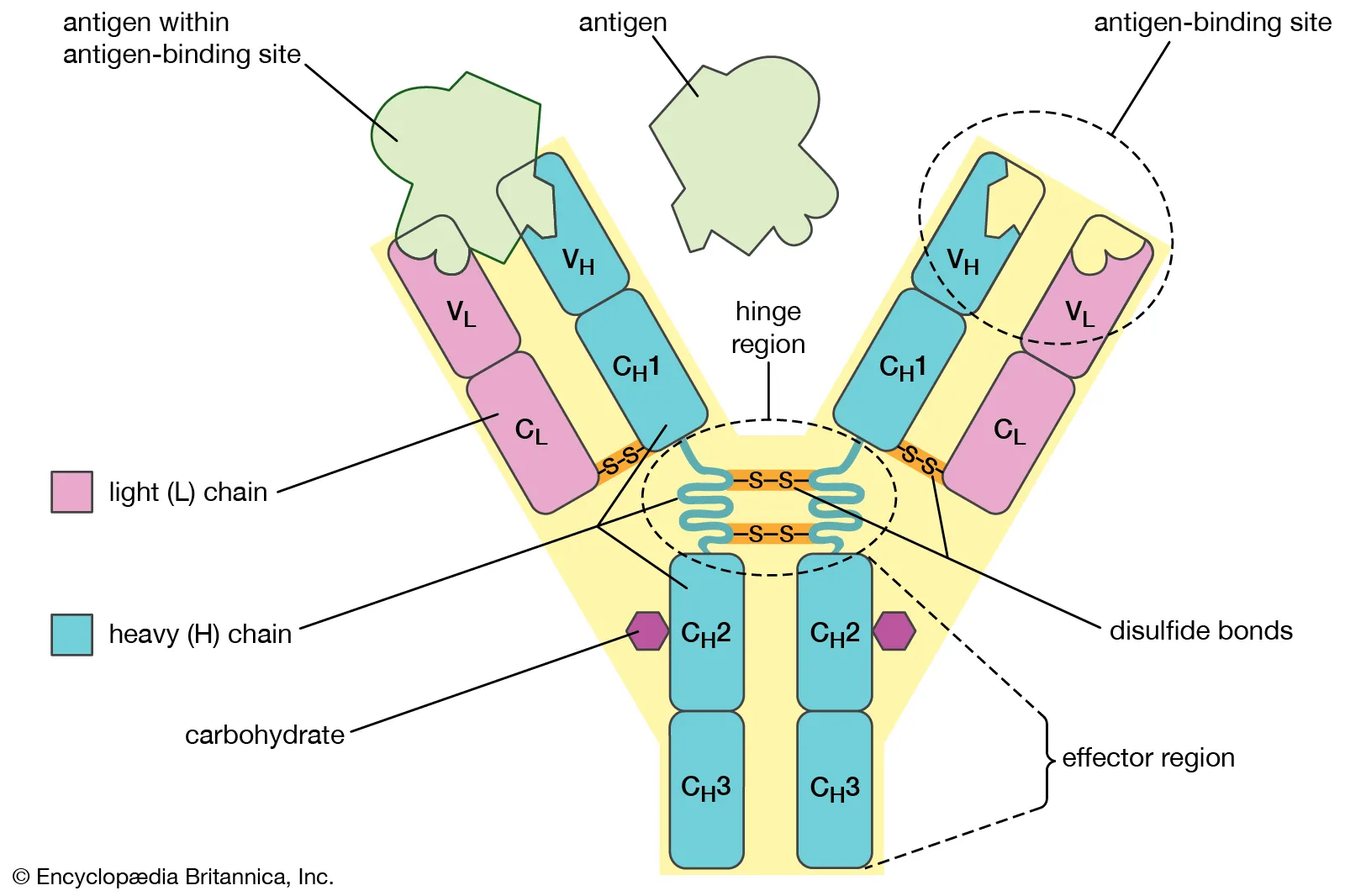
- At the starting end (N-terminus) of the heavy chains, they join with one of the light chains to create two antigen-binding domains. These domains form the arms of the “Y” shape and are referred to as fragment antigen-binding (Fab) domains.
- Towards the ending end (C-terminus) of the heavy chain, the fragment crystallization (Fc) domain is formed. This domain plays a role in the interaction between the antibody and the effector cells.
- The connection between all four polypeptide subunits is maintained by both disulfide and non-covalent bonds.
- The heavy chains of the antibodies consist of a variable region and three constant regions. Each antibody possesses two identical antigen-binding sites, and the antibodies differ from one another in terms of these binding sites.
Different types of Antibody
There are 5 types of antibodies based on H chains:
IgM
- IgM, the largest type of antibody, forms a five-unit structure and is produced by B cells in response to a microbial attack.
- It travels through the bloodstream and lymphatic system, making up about 6% of the total antibodies present in the serum.
- IgM plays a role in opsonization and agglutination processes.
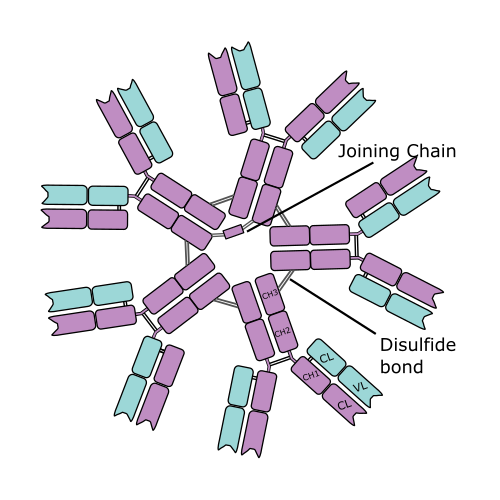
IgG
- Among the different types of antibodies, IgG stands out as the most plentiful in the plasma, making up a significant 80% of the total antibodies in the serum. It is crucial for the protection of the infant in the womb as it can be passed through the placenta.
- IgG is further classified into four subclasses: IgG1, IgG2, IgG3, and IgG4. However, only IgG3 and IgG4 have the ability to cross the placenta.
- The heavy chains of IgG, belonging to the gamma subclass, possess two antigen-binding sites. This characteristic aids in the process of phagocytosis and contributes to providing immunity to the developing fetus.
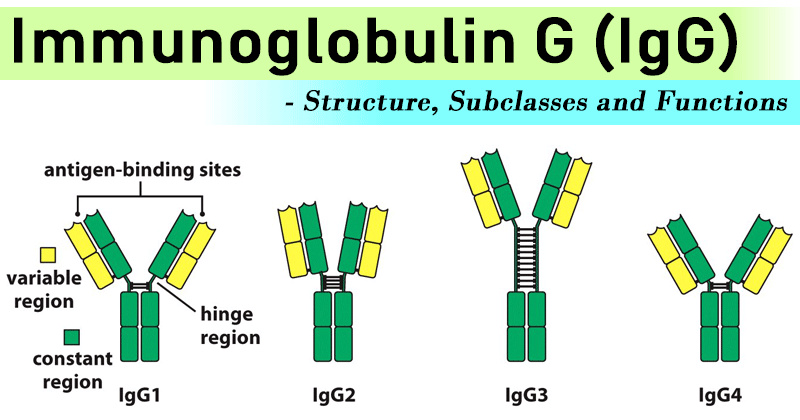
IgA Antibody
- IgA is commonly present in liquids like breast milk, serum, saliva, and intestinal fluids.
- In breast milk, IgA plays a vital role in safeguarding an infant’s gastrointestinal tract from harmful microbes.
- This antibody is classified into two sub-classes: IgA1 and IgA2. IgA1, often referred to as secretory immunoglobulin, is particularly abundant in secretions.
- IgA serves as the initial defense against pathogens, acting as the first line of protection, and also helps in controlling inflammation.

IgD
- IgD plays a crucial role in the creation of antibodies by B cells.
- Although it makes up less than 1% of the total antibodies in the serum, IgD serves as a receptor on the surface of B cells. It is responsible for activating and differentiating these cells.
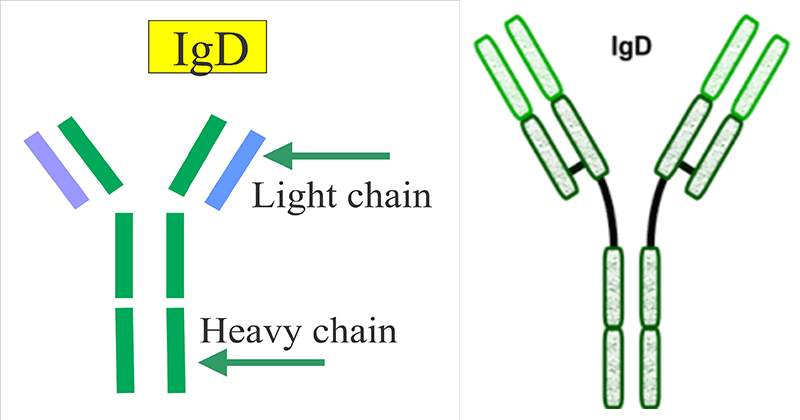
IgE
- IgE is found in minimal amounts, accounting for about 0.02% of the antibodies in the serum.
- These antibodies are located in the linings of the respiratory and intestinal tracts and play a key role in responding to allergic reactions.
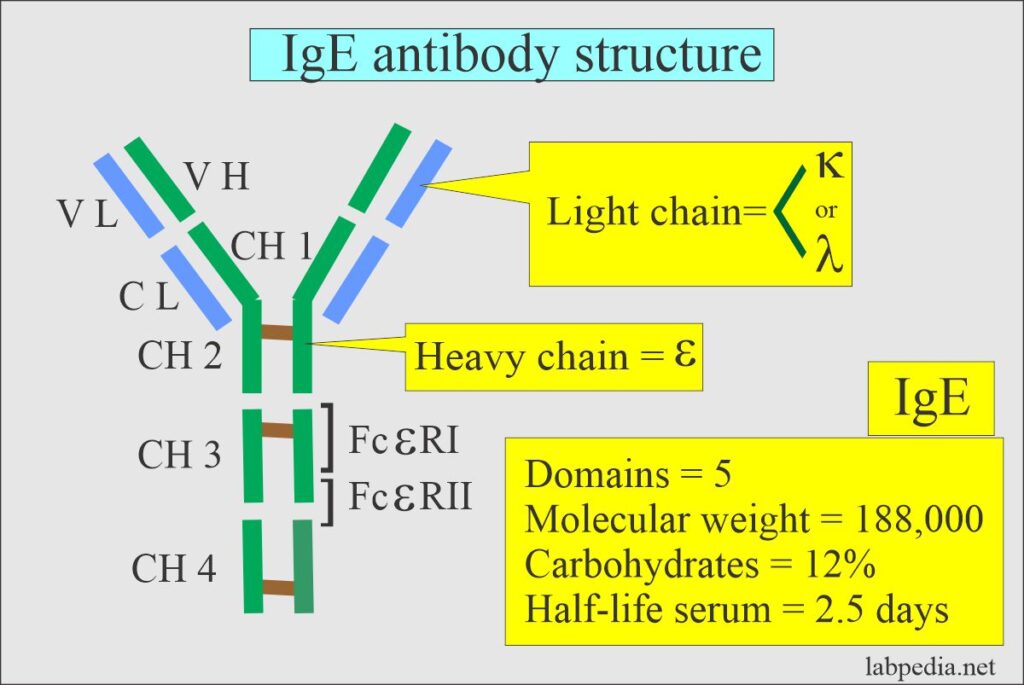
Points to Remember
- An antibody, often called an immunoglobulin (Ig), is a crucial component of our immune system.
- Colostrum, which contains antibodies like IgA, is an example of passive immunity that a mother provides to her child.
Colostrum, a fluid produced by humans, cows, and various mammals before the release of regular breast milk, is highly nutritious. It boasts elevated levels of antibodies—proteins that combat infections and bacteria. Serving as the initial milk produced during pregnancy, colostrum is a rich source of antibodies, proteins, and minerals crucial for the development of your baby's immune system. It differs from regular milk, being thicker and yellower. Colostrum plays a vital role in protecting against infections and fostering developmental growth.
Immune System
- Our body’s defense mechanism, known as the immune system, is a collaboration of cells, tissues, and organs that work together to safeguard our health. This system acts as a shield, protecting the body from invading pathogens through various means.
- The key players in the immune system are white blood cells, also called leukocytes. These cells play a crucial role in eliminating disease-causing organisms and harmful substances.
- Additionally, lymphoid organs, tissues, and antibodies—protein molecules—are also vital contributors to this defense system.
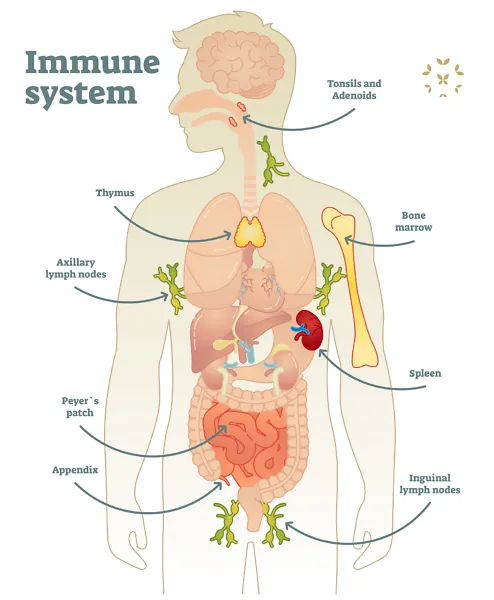
Lymphoid Organs
- The immune system has special organs called lymphoid organs that protect the body from harmful invaders like infections or the spread of tumors.
- These organs include the bone marrow, blood vessels, lymph nodes, lymphatic vessels, thymus, spleen, and other groups of lymphoid tissue.
- Lymphoid organs are where lymphocytes, important cells in the immune system, are formed, matured, and multiply. They can be primary, secondary, or tertiary, depending on their stage of development.
- These organs are made up of fluid connective tissues containing various types of white blood cells, with lymphocytes being the most significant percentage among them.
Primary Lymphoid Organs
- Primary lymphoid organs play a crucial role in producing and maturing lymphocytes, which are essential for our immune system. They are often called central lymphoid organs because they generate lymphocytes from immature cells.
- Two examples of primary lymphoid organs are the thymus and the bone marrow. These organs contribute significantly to the development and maturation of lymphocytes, strengthening the body’s defense against infections and diseases.
Secondary Lymphoid Organs
- Secondary lymphoid organs, also known as peripheral lymphoid organs, play a crucial role in facilitating the interaction of lymphocytes with antigens, helping them become effector cells. These organs are responsible for kickstarting the adaptive immune response.
- Examples of secondary lymphoid organs include the spleen, tonsils, lymph nodes, appendix, and more. These organs are vital for our immune system, working together to combat infections and support overall health.
Tertiary Lymphoid Organs
- Tertiary lymphoid organs typically have fewer lymphocytes but play a significant role during inflammation processes. These organs contribute to the body’s response when there’s inflammation, assisting in the overall defense mechanism.
Human Immune System FAQs
Boost your immune system by adopting a diet rich in fruits and vegetables, regular exercise, maintaining a healthy lifestyle, and avoiding infections.
Signs of a weakened immune system include frequent illnesses, elevated stress levels, delayed wound healing, and gastrointestinal issues.
The gut is recognized as the largest lymphoid organ in the body.
There are two main types of immunity in humans: Innate immunity and Acquired immunity. Acquired immunity is further categorized into Active immunity and Passive immunity.
Foods like citrus fruits, red bell peppers, broccoli, garlic, ginger, spinach, yogurt, and almonds are known to enhance immunity.
A robust immune system effectively protects against common ailments such as colds and influenza.

